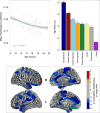Modular Segregation of Structural Brain Networks Supports the Development of Executive Function in Youth
- PMID: 28552358
- PMCID: PMC5491213
- DOI: 10.1016/j.cub.2017.04.051
Modular Segregation of Structural Brain Networks Supports the Development of Executive Function in Youth
Abstract
The human brain is organized into large-scale functional modules that have been shown to evolve in childhood and adolescence. However, it remains unknown whether the underlying white matter architecture is similarly refined during development, potentially allowing for improvements in executive function. In a sample of 882 participants (ages 8-22) who underwent diffusion imaging as part of the Philadelphia Neurodevelopmental Cohort, we demonstrate that structural network modules become more segregated with age, with weaker connections between modules and stronger connections within modules. Evolving modular topology facilitates global network efficiency and is driven by age-related strengthening of hub edges present both within and between modules. Critically, both modular segregation and network efficiency are associated with enhanced executive performance and mediate the improvement of executive functioning with age. Together, results delineate a process of structural network maturation that supports executive function in youth.
Keywords: DTI; MRI; adolescence; brain; connectome; development; executive; module; network; tractography.
Copyright © 2017 Elsevier Ltd. All rights reserved.
Figures







References
-
- Biswal B, Yetkin FZ, Haughton VM, Hyde JS. Functional connectivity in the motor cortex of resting human brain using echo-planar MRI. Magn Reson Med. 1995;34:537–41. - PubMed
MeSH terms
Grants and funding
LinkOut - more resources
Full Text Sources
Other Literature Sources

